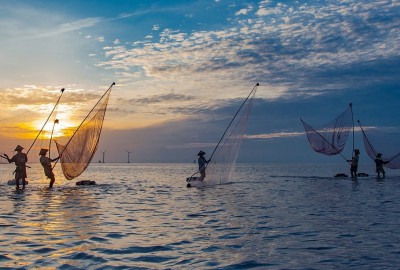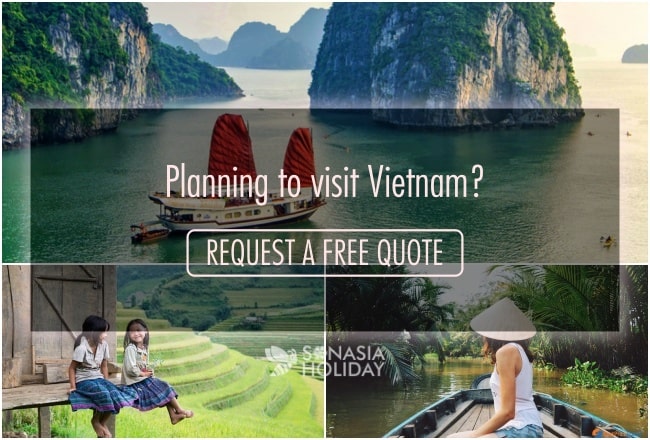Visit Vietnam in about 1 Week
Bustling cities and incredible natural beauty make Vietnam an incredible country to visit, even if you can only stay for about 1 week. In about seven days, you’ll be able to see Vietnam’s highlights, making your way from Ho Chi Minh City in the south to Ha Long Bay in the far north.

guaranteed! REQUEST A FREE QUOTE
We believe you have the right to arm yourselves with as much information as possible before making any decision.
Check below our detailed tips & guide for every places to visit in Vietnam, recommendation regarding the inclusion in each theme you prefer, and what you can do based on the time frame you have.

The Red River flows 700 miles from the Himalayas in Yunnan to the Gulf of Tonkin in Vietnam and as the original route to the coast, until replaced in colonial times by the railway to Hai Phong. In Vietnam it was the scene of historic triumphs over the Chinese.
From Ha Long Bay to Hanoi and the highlands, the (Song Hong) Red River and its tributaries drift through a landscape of limestone karsts, luxuriant hills, misted mountains and bright emerald rice paddies.
Explore the Red River Delta and its surrounding through northern Vietnam allowing access to historic sites, highland Vietnam, hill tribes and the classic landscapes and waterscapes of Indochina. The Hanoi of today is without question one of the most fascinating cities in South East Asia.
No other can compare in terms of the concentration of quality architecture, built during the Chinese and French colonial eras. As a result of the country’s isolation from western development after 1954, Hanoi is preserved as a magnificent tribute to a great era of colonial architecture.
Within the exploration of Northeastern route, you will discover the charm and natural beauty of Northeastern Vietnam, including: Ba Be Lake, Rocky Dong Van Plateau, Ban Gioc Waterfall and Halong Bay. You will meet many hill tribes and have a chance to stay in their traditional houses on stilts.
Ba Ba Lake which is an incredibly beautiful area boasting waterfalls, rivers, deep valleys, lakes and caves set amid towering limestone peaks. This lake, though less visited than other national parks, has been recognized as the third Ramsar in Vietnam. The National Park includes three interconnecting lakes which can be explored on a private long tail boat. The locals are from the Tay minority people, who have adapted their lakeside stilted homes to offer comfortable rooms for visitors.
Continue further north to Dong Van Plateau. You will visit the small communities of Quan Ba, Yen Minh and Dong Van, some of the most picturesque villages in the northern tip of Vietnam.
Next, you’ll then drive to Cao Bang, an area of incredible scenery, including mountains, grottos, rivers and waterfalls. You’ll visit the Ban Gioc Waterfall on the China-Vietnam border, 85km from Cao Bang, passing through spectacular scenery en-route.
You’ll also visit Halong Bay for a memorable adventure on one of the most beautiful bays of the World. You can engage in kayaking and cave climbing, but you will also relax in style on a wooden junk featuring twenty luxurious cabins furnished in classic Eastern style. A truly memorable experience awaits passengers as you cruise this delightful bay, reveling in its tranquility and natural beauty.
Northwest loop of Vietnam take you to Mai Chau, Son La, Dien Bien Phu, Lai Chau, Phong Tho and Sapa all around the Northwest Vietnam: discover the most significant historic sites and stunning landscape with unique ethnic communities; scenic road excursions; experience rural villages; hear history stories and conquer the breath-taking pass; waterfall and valleys filled with majestic hill-side rice terraces & house-on-stilts.
Sapa
Sapa is oriented to make the most of the spectacular views emerging on clear days; it overlooks a plunging valley, with mountains towering above on all sides. Views are often subdued by thick mist rolling across the peaks, but even when it's cloudy, local hill-tribe people fill the town with colour.
Mai Chau
Three hours out from the Vietnamese capital of Hanoi, as you cross into the mountainous Hoa Binh province to the west, the landscape transforms from congested rowhouses to wide-open ricefields, karst mountains, and quaint wood-and-bamboo villages.
Welcome to Mai Chau, a rural valley whose towering cliffs, unique culture and laid-back atmosphere attract visitors keen to experience the land and lifestyle of Vietnam's northwest. Spend a couple of days here, and you'll forget what century you're in.
Spend the daylight hours exploring the local Tai Dam and Tai Kao villages and biking around the brilliant-green rice fields, then fill your evenings drinking the local beer and enjoying traditional Tai dances. Check off the activities listed below, and you can boast you've made the most of your Mai Chau getaway!
Pu Luong
One glance at the Pu Luong Nature Reserve and you’ll see why the ethnic Thai people made this enchanting valley their home long ago. The slow pace in Pu Luong is a striking contrast to life in the capital just a few hours away. Endless mountains, fertile valleys and pristine jungle are just a few good reasons to visit. Here are seven ways to make the most of your time in this beautiful destination.
Dien Bien Phu (DBP)
Dien Bien Phu plays a star role in Vietnam's modern history. It was in the surrounding countryside here, on 7 May 1954, that the French colonial forces were defeated by the Viet Minh in a decisive battle, and the days of their Indochina empire became numbered.
Son La
The region is one of Vietnam’s most ethnically diverse and home to more than 30 different minorities, including Black Thai, Meo, Muong and White Thai. Vietnamese influence was minimal until the 20th century, and from 1959 to 1980 the area was part of the Tay Bac Autonomous Region.
Lai Chau
Lai Chau is a province located 450 kilometres from Hanoi in northern Vietnam, and is particularly known for its mountains and ethnic minorities. The landscape is beautiful and made up of high mountain ranges stretching from the northwest to the southeast with narrow valleys, beautiful rivers and springs completing the natural beauty of the place.
And much much more awaiting for your exploration
Central Vietnam is characterized by a rich historical and cultural heritage, vast sandy beaches and magnificent national parks. Our trip to Vietnam takes us to four world heritage sites listed by UNESCO: the ancient imperial city of Hue, which is full of palaces, tombs, temples, Hoi An - a charming museum city, the mystery remains of My Son, the exceptional caves of Phong Nha - Ke Bang National Park.
Hoi An
Stubbornly traditional and jam-packed with sights, the small city of Hoi An also exudes a laid back, almost dreamy atmosphere that makes it an essential stop on any tour of the country. This intriguing place, with its narrow streets comprising wooden-fronted shophouses topped with moss-covered tiles, has much to recommend it, not least the fact that a concerted effort has been made to retain the city’s old-world charm: by way of example, it’s the only place in Vietnam that places restrictions on motorbike use, and the only place that forces local businesses, by law, to dangle lanterns from their facades. These come to the fore as evening encroaches, and by nightfall you’ll see them shining out from narrow alleys and the riverbank in their hundreds, the light reflecting in the waters of the Thu Bon River. Also notable are the city’s many cheap tailors, who will whip up made-to-measure clothes in no time, and a culinary scene that ranks among the best in Asia.
Hue
Pronounced ‘hway’, this deeply evocative capital of the Nguyen emperors still resonates with the glories of imperial Vietnam, even though many of its finest buildings were destroyed during the American War.
Hue owes its charm partly to its location on the Perfume River – picturesque on a clear day, atmospheric even in less flattering weather. Today the city blends new and old as sleek modern hotels tower over crumbling 19th-century Citadel walls.
A few touts are a minor hassle, but Hue remains a tranquil, conservative city with just the right concentration of nightlife.
Da Nang
Nowhere in Vietnam is changing as fast as Danang. For decades it had a reputation as a provincial backwater, but big changes are ongoing. Stroll along the Han riverfront and you'll find gleaming new modernist hotels, and apartments and restaurants are emerging. Spectacular bridges now span the river, and in the north of the city, the landmark new D-City is rising from the flatlands. Venture south and the entire Danang Beach strip is booming with hotel and resort developments.
That said, the city itself still has few conventional sightseeing spots, except for a very decent museum and a stunningly quirky bridge (or three). So for most travellers, a few days enjoying the city’s beaches, restaurants and nightlife is probably enough. Book an after-dark tour to see Danang at its shimmering neon-lit best. The city's street-food scene also deserves close investigation.
Phong Nha Ke Bang
Designated a Unesco World Heritage Site in 2003, the remarkable Phong Nha-Ke Bang National Park contains the oldest karst mountains in Asia, formed approximately 400 million years ago. Riddled with hundreds of cave systems – many of extraordinary scale and length – and spectacular underground rivers, Phong Nha is a speleologists’ heaven on earth.
The Phong Nha region is changing fast. Son Trach town (population 3000) is the main centre, with an ATM, a growing range of accommodation and eating options, and improving transport links with other parts of central Vietnam.
The caves are the region's absolute highlights, but the above-ground attractions of forest trekking, the area's war history, and rural mountain biking mean it deserves a stay of around three days.
Central Vietnam is famous for endless sandy beaches especially from Da Nang further to the south with some of the most beautiful beach in the world including My Khe Beach, Nha Trang Beach, Vinh Hy Bay, or Phan Rang Beach
Da Nang's Beaches
A one-time French colonial port on the central coast, Vietnam's third-largest city is also home to some of the country's best beaches. And it's got a little something for everyone, from the bustling beaches located a short drive from city to the more secluded spots for those keen on adventure.
Fans of water sports can visit My Khe Beach, the closest beach to the city center and a world-renowned favorite for surfing, snorkeling, and jet-skiing. Meanwhile, those who prefer some privacy can hop on a motorbike to the untouched Tien Sa Beach on the north side of the Son Tra Peninsula. Other nearby attractions include the stunning Phong Nha-Ke Bang National Park, Caves, a UNESCO World Heritage Site that is home to Son Doong, the world's largest cave.
Nha Trang
Big enough to bustle, yet small enough to retain its relaxed air, the delightful city of Nha Trang has, despite increasingly stiff competition, earned its place as Vietnam’s top beach destination. A grand 6km scythe of soft yellow sand is lapped by rolling waves on one side and fringed on the other by cafés, restaurants, hotels and some unusual modern sculptures.
Hawkers are on hand to supply paperbacks, fresh pineapple and massages, while scuba-diving classes and all kinds of watersports are available. Local companies also offer popular day-trips to Nha Trang’s outlying islands, combining hiking, snorkelling and an onboard feast of seafood. Bear in mind that the rainy season, around November and December, sees the sea get choppy and the beach loses much of its appeal.
Ninh Van Bay
Welcome to an alternative reality populated by European royalty, film stars and the otherwise rich and secretive. For the average punter not able to afford an uber-luxurious hotel, this place doesn’t exist. Well, at least not before 2017, when the mother-of-all flashpacker retreats opened here on a private bay.
Ninh Van Bay is all about get-away-from-it-all beach bliss, and there's a sprinkling of exquisite sandy coves you can reach by kayak, SUP or boat. There's no road access to the region.
Vinh Hy Bay
Vinh Hy is a gorgeous natural harbour between Phan Rang and Nha Trang. Accessed via the spectacular Nui Chua Coast Road, the bay is a perfect crescent of blue water hemmed in by rocky cliffs covered in forest. A fishing fleet of blue wooden boats occupies the bay, around which clusters the tiny village of Vinh Hy.
Phan Rang
Sitting bang in between Vietnam’s long-established kitesurfing mecca- Mui Ne– and the raucous city streets of Nha Trang, Phan Rang, Ninh Thuận Province, is the new up-and-coming spot that’s captured the attention of adventure travellers around the globe
Exploring the bustling city of Ho Chi Minh and marveling at the peasant life of Mekong River Delta. Traveling to the heart of the Mekong Delta adventure from Ho Chi Minh City. Boarding a private longtail boat, experience the diversity of the Mekong waterways first hand as you explore fish farms, exotic fruit farms and dine on traditional Mekong Delta food.
Ho Chi Minh
Ho Chi Minh City (HCMC) is Vietnam at its most dizzying: a high-octane city of commerce and culture that has driven the country forward with its pulsating energy. A chaotic whirl, the city breathes life and vitality into all who settle here, and visitors cannot help but be hauled along for the ride.
From the finest of hotels to the cheapest of guesthouses, the classiest of restaurants to the tastiest of street stalls, the choicest of boutiques to the scrum of the markets, HCMC is a city of energy and discovery.
Wander through timeless alleys to incense-infused temples before negotiating chic designer malls beneath sleek 21st-century skyscrapers. The ghosts of the past live on in buildings that one generation ago witnessed a city in turmoil, but now the real beauty of the former Saigon’s urban collage is the seamless blending of these two worlds into one exciting mass.
Mekong River Delta
The ‘rice bowl’ of Vietnam, the delta is carpeted in a dizzying variety of greens. It's a water world that moves to the rhythms of the mighty Mekong, where boats, houses and markets float upon the innumerable rivers, canals and streams that criss-cross the landscape like arteries.
The bustling commerce of its towns contrasts sharply with the languid, almost-soporific pace of life in the countryside. Here buffalo wallow in rice paddies, coconut- and fruit-laden boats float slowly along the mud-brown waters, and two-wheeled exploration of the narrow lanes is amply rewarded with a true taste of rural hospitality (and delicious river fish).
Elsewhere, mangrove forests teem with a wealth of bird life and bristle with the remains of Viet Cong bunkers, ornate Khmer pagodas and Buddhist temples reaching for the sky, while off-coast islands offer white-sand beaches and tropical hideaways to some, and pirate havens to others.
The Southern Vietnam Coast is famous for its dreamy beaches such as Mui Ne, Phu Quoc Island, or the authentic Con Dao Island. They are the rising stars among the famous destination for beach holiday in Southeast Asia.
Mui Ne
Once Mui Ne was an isolated strip of coastline with a small traditional fishing village, where only the adventurous travelers camped on the beach. The original fishing village is still there, but nowadays there are more tourists than locals. It has now become a tourist beach destination with a number of luxury hotels, a few cheap hostels, but above all a midrange hotels. The sights on Mui Ne and Phan Thiet range from beautiful beaches, tropical forests and sand dunes to traditional villages, fishing port and ancient Cham buildings and ruins.
Phu Quoc Island
Fringed with white-sand beaches and with large tracts still cloaked in dense tropical jungle, Phu Quoc rapidly morphed from a sleepy island backwater to a must-visit beach escape for Western expats and sun-seeking tourists. Beyond the resorts lining Long Beach, rapid development beginning on the east coast and mega resorts in sight of Sao Beach, there's still ample room for exploration and escaping the sometimes littered waters. Dive the reefs, kayak in the bays, eat up the back-road kilometres on a motorbike or just lounge on the beach, followed by a massage and a fresh seafood dinner.
Phu Quoc is not really part of the Mekong Delta and its rice production; the most famous, and valuable, crop is black pepper. Yet the islanders here have traditionally earned their living from the sea, and its claim to fame across Vietnam is the production of high-quality fish sauce (nuoc mam).
Con Dao Island
Isolated from the mainland, the Con Dao islands are one of Vietnam's star attractions. Long the preserve of political prisoners and undesirables, they now turn heads thanks to their striking natural beauty. Con Son, the largest of this chain of 15 islands and islets, is ringed with lovely beaches, coral reefs and scenic bays, and remains partially covered in tropical forests. In addition to hiking, diving and exploring deserted coastal roads there are excellent wildlife-watching opportunities, such as the black giant squirrel and endemic bow-fingered gecko.
Although it seems an island paradise, Con Son was once hell on earth for the thousands of prisoners who languished in a dozen jails during French rule and the American-backed regime. Many Vietnamese visitors are former soldiers who were imprisoned on the island.
Until recently, few foreigners visited Con Dao, but with the commencement of low-cost boat connections this looks sure to change.



















